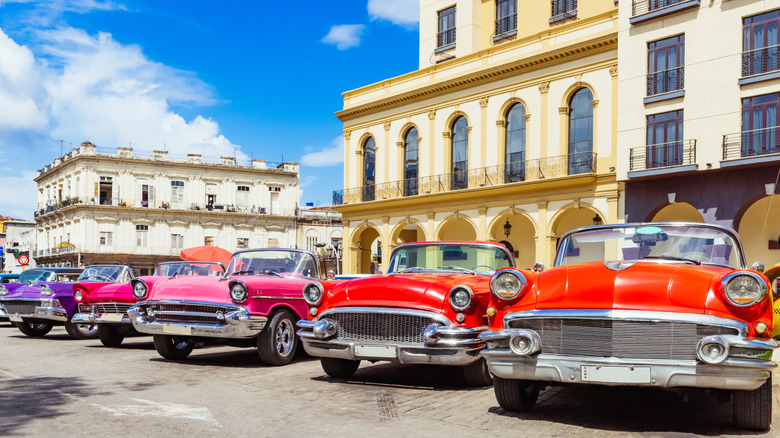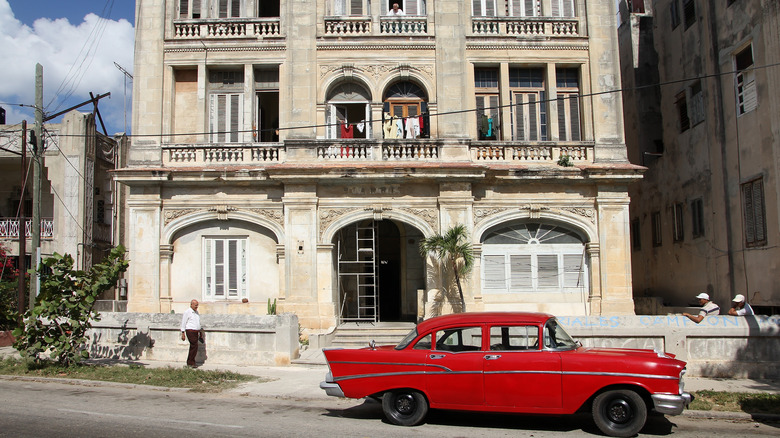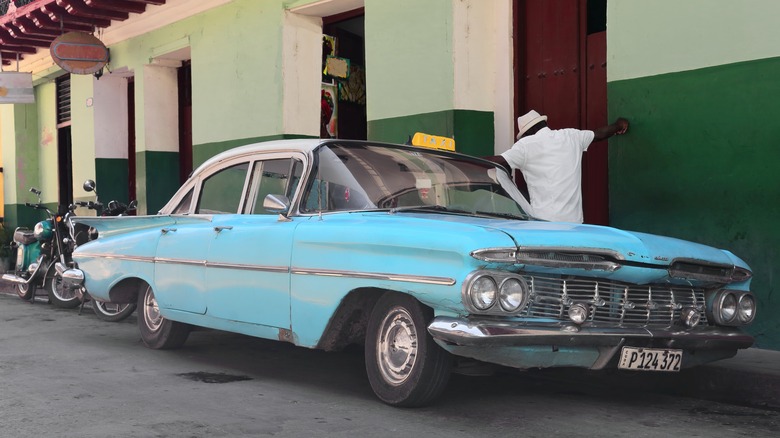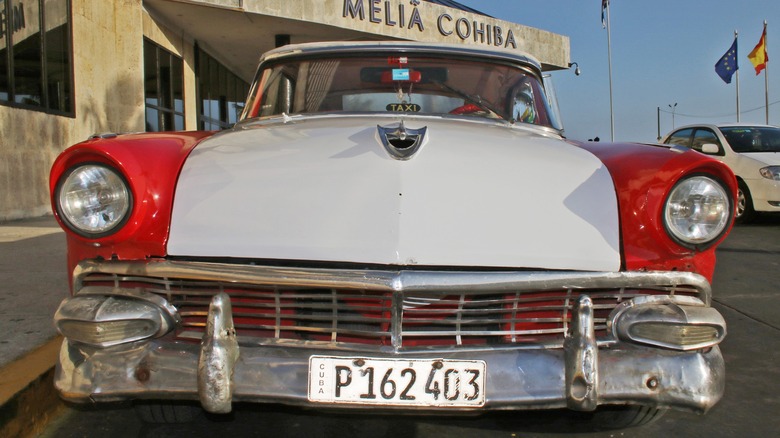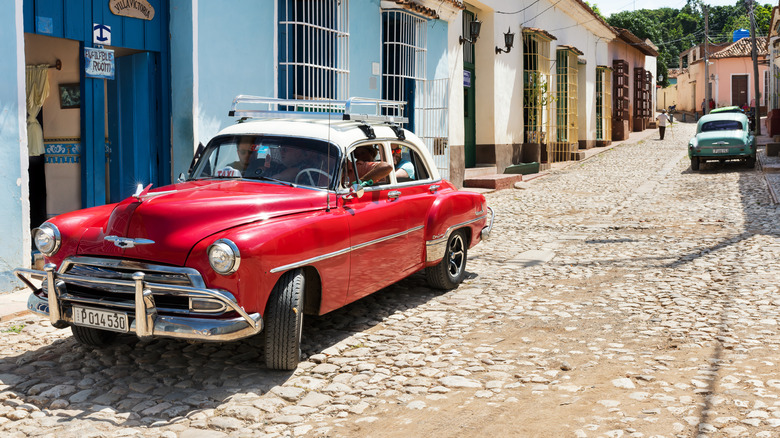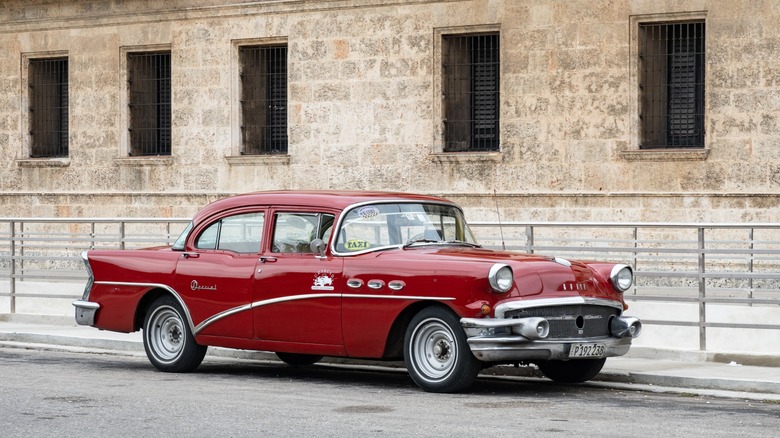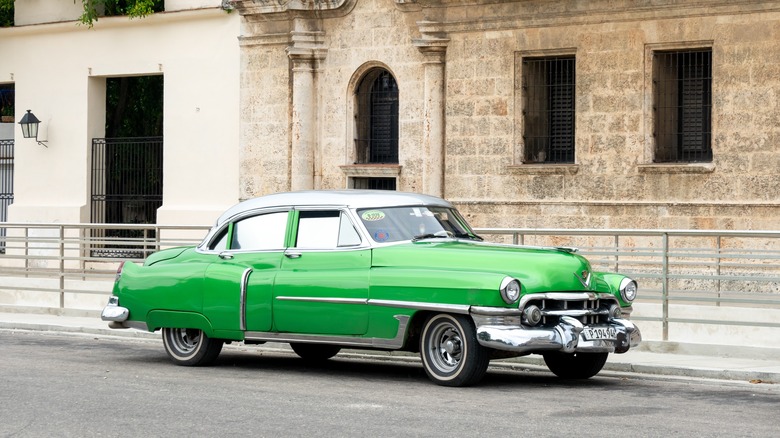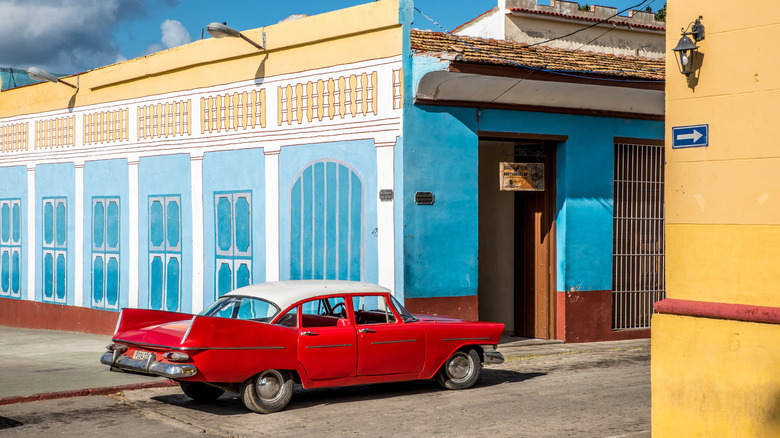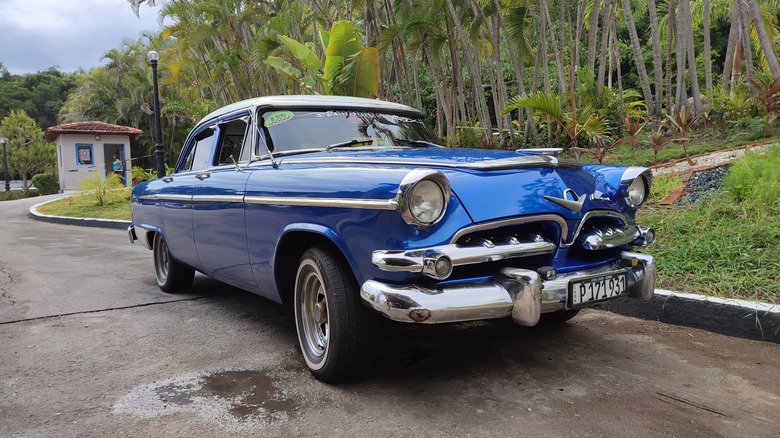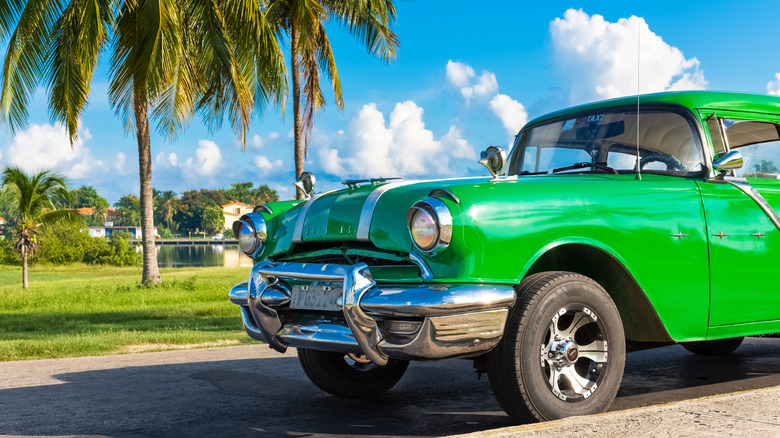9 Classic American Cars You Can Still See Driving The Streets In Cuba
Before the Batista government was overthrown on New Year's Day 1959 and the subsequent U.S. trade embargo in 1962, Cuba was a major importer of American vehicles. At one point, there were over 140,000 of Uncle Sam's finest on the island, mostly imported during the Caribbean country's golden era of the '40s and '50s. Chevys, Fords, Cadillacs — just about any classic car from that period could be seen flamboyantly parading up and down Havana's streets to the swinging beats of salsa and mambo.
However, the embargo halted car imports, which forced Cubans to maintain the vehicles they had. Islanders were forced to learn the skills of the mechanic in order to keep their beloved cars on the road. Essential parts were imported from their comrades in other countries, and together with a little love, care, and a healthy dose of creativity, many of these cars survived the hardships and remain on the streets of Cuba today.
In fact, as many as 60,000 of these now vintage cars endured, and a healthy percentage of them are in tip-top condition. Most of them are still put to work in some capacity, serving as daily drivers, tour vehicles, or tourist taxis. Even the more beaten-up relics still have life left in them, with some put to use as shared transportation for locals.
This Caribbean automotive museum looks to remain a bucket-list destination for classic car lovers for a time yet, as the embargo is still firmly in place. However, pressure is mounting to end the blockade and travel restrictions are relaxing, so it may not be for too much longer. For now, however, the country's vintage vehicles continue to be symbolic of Cuban ingenuity and resourcefulness while also offering nostalgic tourists a unique glimpse into the past.
Chevrolet Bel-Air
One of the most common classic American cars you can see on the streets of Cuba today is the Chevrolet Bel-Air. The 1957 model was a common import before the embargo thanks to a love for its striking aesthetics of sweeping curves, plentiful chrome, and eye-catching tailfins that matched the passionate spirit of Cuban culture.
It was available as a two-door coupe or four-door sedan in convertible or hardtop form. Many have been immaculately maintained. However, if you were to sneak a peek under the hood of a Cuban Bel-Air today, you would likely find a Soviet-era engine in place of the original six-cylinder or V8. Furthermore, due to limited spare parts, Cubans had to rely on some more unconventional methods to keep their Bel-Airs running. These included using shampoo as brake fluid or even applying toothpaste to buff the chrome. Cubans also had to deal with the constant threat of sea air, which can be a menace for car owners, especially when you need the vehicle to last decades.
In the United States today, well-maintained Bel-Airs can reach significantly high prices. In fact, in 2022, a 1957 Bel-Air custom convertible fetched a whopping $330,000 at the Barrett-Jackson auction in Scottsdale. With the Bel-Air reputation enduring decades after its production ceased, it's intriguing to think if there are Cubans with pristine garage-stored specimens just waiting for a cash-in opportunity.
Chevrolet Impala
The Bel-Air isn't the only Chevy on the streets of Cuba. Another highly cherished model is the Impala. The 1959 model particularly holds a special place in the hearts of many Cubans. This is because one belonged to none other than Ernesto "Che" Guevara, who was a chief architect in the Cuban revolution alongside Fidel Castro.
He owned an emerald-green Impala that is another to have survived the years. If you're lucky enough, you may even get to see this classic American car in the courtyard of his former family home in Havana. It proudly sits alongside a replica of the revolutionary's La Poderosa motorbike that featured in the 2004 biopic "The Motorcycle Diaries."
The first generation of Impala — introduced to the world in 1958 — is the most valuable of all. The 1959 second generation marked a significant stylistic departure, with the previous jet-inspired extravagance replaced by a sleek, streamlined look with subtle curves. At the time, many felt the changes were too radical. However, Chevrolet produced more than 1.4 million units, which cemented the car's presence on the streets of Havana. However, the grandiose first generation is also much-loved and prevalent in Cuba.
Ford Fairlane
In 1962, the Ford Fairlane transitioned to a mid-sized car. This means that the full-sized Fairlane produced from 1955 is still a common sight on the streets of Cuba today. This model was named after Henry Ford's estate in Michigan, and the car sold quite well in its debut year. Of course, many of those ended up decorating the streets of a certain communist Caribbean country.
Cubans greatly appreciated the Fairlane's roomy interior and robust engine. The whole family could fit inside and it could easily navigate the island's variety of terrain. With the base model sporting a 223-cubic-inch six-cylinder engine and the more powerful V8 options offering from 272 to 292 cubic inches with up to 182 horsepower, family vacations around the island were taken care of. However, in today's Cuba, these engines are more likely to have been swapped out for more economical diesel engines.
The convertible was the most natural choice for a tropical island, which is why Pierce Brosnan can be seen driving in his James Bond movie "Die Another day." While parts of the 2002 movie were set in Cuba, filming actually took place in Spain, but the brown- and cream-colored convertible was carefully selected to support the Cuban setting. Despite its limited screen time and lack of Bond-esque stunts or chases, the 1957 Ford Fairlane convertible still ranked surprisingly high on our list of James Bond movie cars.
Chrysler New Yorker
Cuba was a thriving tourist destination and a wealthy market during the American automobile golden age of the 1950s. Affluent residents sought out luxury cars such as the Chrysler New Yorker. However, there is a specific 1955 New Yorker that is famous on the island. It belonged to the celebrated American novelist Ernest Hemingway, who resided in Cuba for two decades.
He owned a two-tone Navajo Orange and Desert Sand model that boasted a 331 cubic inch V8 FirePower engine equipped with a four-barrel carburetor setup that produced 250 horsepower. Hemingway paid just shy of $4,000 to purchase the car as a treat to himself after he won the Nobel Prize for Literature in 1954. That year, Chrysler only built 59 New Yorkers for export. Hence, it's sad to discover the disrepair Hemingway's car fell into after the writer's passing in 1961.
Following his death, the car's location was unknown for decades. It was eventually rediscovered, but in poor condition with significant damage and missing parts. Enter David Soul — yes that David Soul, the famous actor from "Starsky & Hutch" who was no stranger to iconic cars himself. Hemingway's dilapidated Chrysler New Yorker became his mission.
The restoration began in 2012. However, due to the embargo and painful Cuban bureaucracy, Soul's team encountered significant delays. Sadly, Soul passed away not long into 2024, with the job incomplete. However, efforts to finish the restoration, as well as the accompanying "Cuban Soul" documentary the actor was shooting, remain ongoing. If completed, an important piece of automotive, literary, and Cuban history will be preserved.
Buick Special
By 1956, somewhere around 143,000 American-made cars graced the streets of Cuba. The Cuban people's favorite brand was undoubtedly Chevrolet, followed closely by Ford. However, Buick was not far behind. This was thanks in large part to the number of American tourists visiting the country who expected a little luxury when it came to being shuttled around the island.
One notable Buick that remains a common sight around Cuba is the Buick Special. This vehicle made its debut in 1936, so there was plenty of time for it to make its way to Cuba before the beginning of the trade embargo. As Buick's entry-level model, it was also a more affordable option for Cubans who didn't come from significant wealth. However, the Buick Special was still a well-regarded model, and later models boasted increased horsepower. The 1956 Special was the first to feature the 322 Nailhead V8, which produced an impressive 220 hp. However, like other classic American cars in the country, those engines have long since been stripped down and replaced.
Nowadays, the Buick Special is commonly used as a tourist taxi or private transportation. While they can be heavy investments, chaperoning tourists around is a very lucrative business. Taxi drivers in Cuba will tell you that a $60 profit is a bad day. When you consider that professionals such as doctors, nurses, and engineers earn as little as $45 per month, it's unsurprising that owning a car like a Buick Special is so coveted.
Cadillac Series 62
The Cadillac Series 62 epitomizes 1950s American luxury, which is when Cuba's affinity with the car brand really kicked into high gear. Back then, the island was one of the predominant importers of Cadillacs worldwide. In fact, it's been reported that at one point there were more Cadillacs per capita gracing the streets of Havana than there were in New York City.
The 1957 Cadillac Series 62, with its lavishly chromed body and boldly shaped tailfins, was a typically designed vehicle of the time. It was available in hardtop coupe, sedan, or convertible form, with the latter being the vehicle of choice for ostentatious Cubans cruising up and down Havana's Avenida Malecón.
At that time, the car would have been equipped with a robust 365-cubic-inch V8 engine delivering up to 300 horsepower. It could reach a top speed of 120 mph, and with an estimated value of around $25,000 in the U.S. today, it is a classic Cadillac you can still pick up relatively cheaply. However, the 1956 Series 62 is also a common sight in Cuba, and these models can fetch up to $50,000 in the U.S.
Visitors to the island can seek out a ride in one of these classic Caddies. Some travelers even hire drivers for multiple days. If there are a few of you in the group, it can work out to be a reasonably cheap excursion for such an authentic experience. Just don't expect your driver to demonstrate the V8 engine's potential, as under the hood, you'll most likely find it long since replaced by a diesel engine.
Plymouth Belvedere
By 1956, the Belvedere had undergone some significant changes in appearance. It adopted a lower and longer body style, extensive use of chrome, and dramatic tailfins for a more modern aesthetic that contrasted with the boxy designs of the time.
The look was ideal for Cubans, and the 1956 Belvedere was a popular import before the embargo. The iconic car's presence is still notable, but one particular vehicle has gained international recognition. Step forward mechanical engineer Ramon Ventura, whose 1956 Plymouth Belvedere received Cuba's first-ever Autos Clasicos concours award in 2018.
This event was significant for the classic car community in Cuba. It was organized in celebration of the 500th anniversary of the capital city and the 120th anniversary of the automobile's arrival on the island. Over 300 hopeful cars went through an initial evaluation process, and the chosen few took part in a grand parade of elegance through the streets of Havana.
As the story goes, Ventura bought his winning car in 1990. It was in immaculate condition, having been cared for intensively by a local priest for over 40 years. Sporting the original V8 engine and 6.70-15 bias-ply tires that matched the historical design, the car received a 98 percent originality score, let down only by a new paint job and upholstery work.
Dodge Custom Royal
One more flashy vehicle from the American automotive industry's late-'50s horsepower wars was the Dodge Custom Royal. From 1955 to 1959, it was the manufacturer's high-end offering, with the '57 to '59 Swept Wing series greatly satisfying consumers' need for speed, style, and performance.
With engines ranging from the standard 1957 Super Red Ram V8 with its respectable 260 hp all the way up to the 1959 Super D-500 that offered 345 hp, these cars delivered. Furthermore, its wraparound bumpers, abundant chrome, and flamboyant fins personified the style that was unconditionally embraced by so many Cubans.
Nowadays, the Custom Royal is a scarce find in the U.S., or most other places, for that matter, especially the 1959 convertible. However, while not as common as other classic American cars in Cuba, they are there and can be found. While many may be in various stages of modification and repair — you can even see the occasional 4-door hardtop transformed into a convertible — others are in excellent condition.
Pontiac Chieftain
The Pontiac Chieftain went through many design changes between 1949 and 1958. The earlier generations stand out in Cuba today thanks to their streamlined shapes, bold chrome accents, and geometric patterns that are typical of the Art Deco style.
Its transformation into a sportier, more youthful car in later generations aligned perfectly with the Cuban market before the revolution. Today, these classic Pontiacs are prized possessions. They may not be as common as Chevys and Fords on Cuban roads, but they are around, and they nicely decorate the streets of Havana whenever seen.
The Chieftain was known for its powerful straight-eight engine, and later models featured a V8. It was a more affordable option back in the day and offered style and performance to those who needed it at a reasonable price. Nowadays, 1956 to '58 Chieftains can reach around $35,000 at auction in the United States and is one Pontiac model that deserves more recognition than it gets.
The car also holds a special place in Cuba's history. This is because Fidel Castro himself owned a Pontiac Chieftain. Following graduation from the University of Havana Law School, a young Castro was gifted a brand-spanking-new Chieftain as a reward from his father. This connection to the island's most important historical figure adds a layer of significance to the Chieftain's Cuban legacy.
